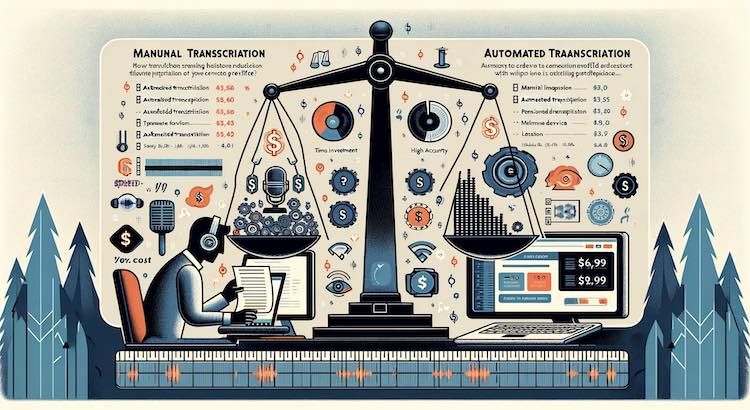Manual vs. Automated Transcription Pricing: A Clear Comparison
Accurate transcription is vital for professionals across industries such as media, law, healthcare, and research. Understanding the pricing differences between manual transcription services and automated transcription can help you choose the best option for your needs. This guide explores cost structures, quality, and how to select the right service for your project.
Manual Transcription Pricing Explained
Manual transcription involves trained professionals who convert audio or video into text. Human transcribers offer high accuracy, but service costs reflect their expertise and the time involved (Statista, 2023).
What Influences Manual Transcription Costs?
Manual transcription is usually priced per minute of audio or video. Several factors can impact the final price:
- Audio quality: Noisy recordings or faint voices are harder to transcribe, leading to higher charges.
- Speaker accents and language: Strong accents or less common dialects may cost more due to the extra effort needed.
- Turnaround time: Faster service comes at a premium, while standard delivery is more affordable.
- Specialized content: Medical, legal, or technical terminology requires expert transcribers, which increases rates.
According to industry reports, manual transcription rates average between $1.50 and $4.00 per audio minute in the United States (Rev, 2023). You can learn more about current transcription pricing on GoTranscript’s cost page.
Why Choose Manual Transcription?
- Highest possible accuracy (over 99%).
- Better for complex audio, multiple speakers, or challenging accents.
- Ideal for sensitive or high-stakes projects (legal, medical, academic).
- Nuanced understanding—humans can catch context and intent that computers may miss.
Manual services are best when you need reliable, publication-ready transcripts with minimal risk of error.
Automated Transcription Pricing Breakdown
Automated transcription uses artificial intelligence (AI) to convert speech to text quickly. These tools can process large volumes of audio much faster than humans and at a fraction of the cost (TechCrunch, 2022).
How Are Automated Transcription Rates Set?
Most AI-powered platforms charge by usage, offering options like:
- Pay-as-you-go per audio minute (often $0.10–$0.30 per minute).
- Monthly subscriptions for unlimited or increased minute packages (starting under $15/month).
- Free or trial tiers with basic features and limited transcriptions per month.
This makes AI transcription subscriptions especially appealing for users with large or ongoing projects.
Considerations with Automated Transcription
- Accuracy averages between 85% and 90% for clear audio (NPR, 2023).
- Lower cost and faster delivery than human-based services.
- Best for high-volume, non-essential projects, or when speed matters most.
- Technical jargon, multiple speakers, or poor-quality audio may decrease accuracy.
While AI transcription is faster and cheaper, it often requires extra review. Consider pairing automated solutions with transcription proofreading services for more accurate results.
Manual vs. Automated: Which Should You Choose?
When Manual Transcription Is Better
- You must have perfect or near-perfect accuracy.
- Transcripts are for court cases, medical records, or published research.
- Audio features challenging accents, technical language, or background noise.
- Context and word-for-word precision matter.
When Automated Transcription Is Ideal
- Speed is more important than perfection.
- Budget is limited, and you need to minimize costs.
- Content is for internal use—drafts, brainstorming, notes, or bulk transcription needs.
- Audio is clear, with few speakers and no specialized vocabulary.
Combining Both for Best Results
Some projects benefit from using both methods. For example, start with automated transcription to save time, then use a manual service or proofreading for a final review. This approach works well for long recordings or when you need to balance cost and accuracy.
Additional Value-Added Services
Many providers offer related solutions to enhance transcripts:
- Closed caption services for accessibility and compliance.
- Subtitling services for videos in multiple languages.
- Text translation services and audio translation to reach wider audiences.
For those considering costs, you can compare captioning services pricing across platforms.
How to Select and Order the Right Service
To order a transcript, upload your files directly through a secure portal like GoTranscript’s order transcription page. If you also need captioning, use the order captions tool.
- Check turnaround times and cost per minute upfront.
- Clarify whether your audio needs human or machine transcription for best results.
- Consider unique project needs—technical content, multi-language requirements, or bulk files.
Conclusion: GoTranscript Offers Complete Transcription Solutions
Choosing between manual and automated transcription comes down to your priorities: accuracy, speed, or budget. Manual transcription ensures unmatched precision, while automated services deliver quick, affordable results. For the best combination, start with AI transcription and finish with human editing.
GoTranscript provides both manual and automated transcription services—plus proofreading, captioning, and translation solutions. Whether your project is large or small, GoTranscript has cost-effective options and free quotes to help you get started with confidence.



















 Verified Order
Verified Order